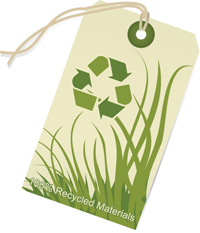
Deciding to go green with paper choices is much easier now compared to decades ago when recycled printing paper first came on the scene. Catalogers’ attitudes have changed as well; a mailer’s environmental commitment is no longer only as strong as its willingness to pay an upcharge for a recycled grade.
But while it is easier to get green, deciding among all the options is a bit more complicated. Is recycled content the goal? Great, but how much? 10%? 30%? 100%?
A starting point and minimum for recycled is 10% post-consumer waste (PCW). Many #2 quality catalog cover grades are 10% PCW as a standard, with no upcharge.
But #3 grades, which many mailers use for their catalog covers, carry an upcharge of $1/hundredweight (cwt) from most paper manufacturers for 10% recycled content. The price continues to rise incrementally with the percentage of post-consumer waste, which may likely be combined with environmentally friendly certifications.
What about the larger portion of the catalog — the body stock? Coated #4 and #5 grade levels are usually available with 10% PCW, also for a small upcharge. At this grade quality level, 10% is typically the maximum recycled content you can get. And yes, even 100% PCW paper is available in some uncoated grades.
All of these papers containing post-consumer waste not only print well, but quality in most cases is almost equal to virgin fiber paper grades.
Get it certified
Aside from recycled content, environmentally friendly certifications from third-party sources are becoming as ubiquitous as, and in some cases even more important than, the recycled content itself. You’ve probably seen acronyms such as FSC, SFI and PEFC. These are the organizations that go after the companies cutting down old-growth trees, such as those found in the boreal and rain forests.
The most recognized is the Forest Stewardship Council. Many paper manufacturers have partnered with FSC, which certifies that the source of the wood fiber has come from a well-managed, sustainable source.
Becker’s School Supplies made the commitment to FSC paper in 2009, says catalog manager Rob Bonczkiewicz. “We felt it was important to consider and ultimately move forward with printing on FSC-certified paper.”
The market Becker’s serves is in tune with and somewhat sensitive to the environment, he notes, “and we as a company are becoming increasingly environmentally conscious as well.”
Keep in mind that for a cataloger to use the FSC logo on the back of the catalog, the paper merchant and the printer must also have certification from FSC. FSC-certified paper does, in general, carry a $1/cwt upcharge. And in many cases, the paper may optionally contain some recycled content, which would also raise the price.
If you have a strong environmental commitment, you can use a 30% PCW FSC paper grade. But it will cost you more. This combination may carry a $3/cwt to $5/cwt upcharge.
A smaller footprint
Paper manufacturers are not only producing increasing amounts of recycled and sustainably certified paper, but are also initiating other plans to reduce greenhouse gases. For instance, Canada’s Cascades Paper not only produces a 100%-recycled grade of paper, it is also looking at ways to reduce its carbon footprint.
At one of its paper mills, Cascades has installed an eight-mile pipeline to a landfill. By using the methane that comes from the decomposition of the landfill waste, the company can meet more than 80% of the mill’s thermal energy needs.
NewPage Corp. is installing wind turbines at its Luke, MD, facility, which will help power the mill. The paper company is also backing an ambitious effort to reduce deforestation in Indonesia: NewPage is funding the World Resources Institutes “Project POTICO” (Palm Oil, Timber, Carbon Offsets), an initiative to combat illegal logging and preserve virgin rain forests in Indonesia by diverting new palm oil plantations to degraded lands.
There are many options for catalogers to be environmentally conscious when making decisions on paper. Asking your paper merchant or printer is a good first step to finding out what is available.
Dan Walsh ([email protected]) is vice president of catalog papers for Chicago-based paper distributor Bradner Smith & Co. (www.bradnersmith.com).
